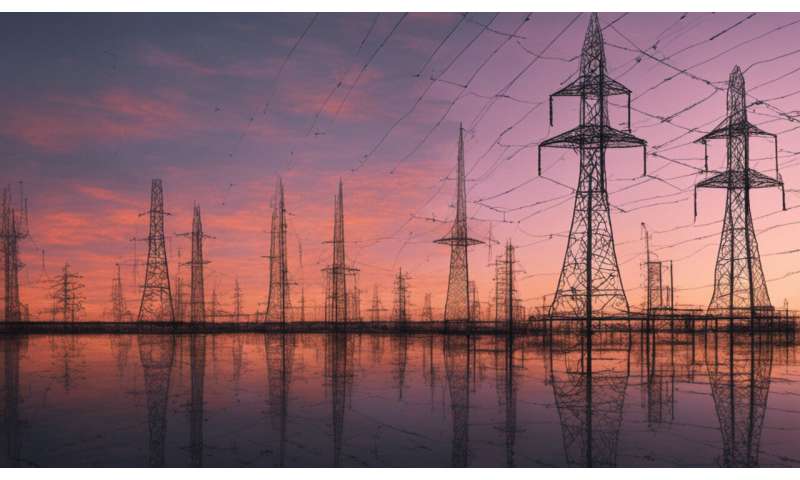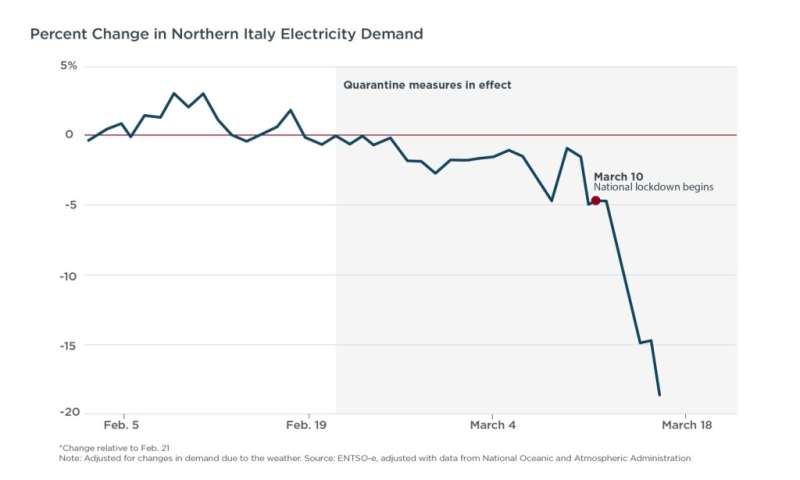by University of Chicago

How do you measure the economic impact of coronavirus?
A UChicago economist says to look at power demands. Credit: Shutterstock.com
With Americans largely self-isolating amid concerns about COVID-19, some of the hardest hit areas are already seeing electricity demand begin to weaken. Could this be a sign of things to come?
University of Chicago economist Steve Cicala examined what has happened to power demand in Northern Italy, which some say is about 11 days ahead of the U.S. trajectory of the novel coronavirus. An assistant professor at the Harris School of Public Policy, Cicala compiled regional grid data, adjusting for weather changes, and found that power demand has plunged in Northern Italy since the middle of February.
On Friday, Feb. 21, life in the region was largely normal. The following day, the Italian government began to institute quarantine measures. By Monday, power demand began to slow. As the chart below shows, there was then a bump in power just before the government instituted a national lockdown about two weeks later on March 10. About a week after that, power demand had fallen 18% compared to demand just prior to the quarantine measures.
An expert on the economics of environmental and energy policy regulation, Cicala said power demand could be a real-time indicator of the more widespread impacts on the Italian economy. And, what is happening in Italy could point to what the United States could expect in the coming weeks as states issue tighter restrictions on daily life.

With Americans largely self-isolating amid concerns about COVID-19, some of the hardest hit areas are already seeing electricity demand begin to weaken. Could this be a sign of things to come?
University of Chicago economist Steve Cicala examined what has happened to power demand in Northern Italy, which some say is about 11 days ahead of the U.S. trajectory of the novel coronavirus. An assistant professor at the Harris School of Public Policy, Cicala compiled regional grid data, adjusting for weather changes, and found that power demand has plunged in Northern Italy since the middle of February.
On Friday, Feb. 21, life in the region was largely normal. The following day, the Italian government began to institute quarantine measures. By Monday, power demand began to slow. As the chart below shows, there was then a bump in power just before the government instituted a national lockdown about two weeks later on March 10. About a week after that, power demand had fallen 18% compared to demand just prior to the quarantine measures.
An expert on the economics of environmental and energy policy regulation, Cicala said power demand could be a real-time indicator of the more widespread impacts on the Italian economy. And, what is happening in Italy could point to what the United States could expect in the coming weeks as states issue tighter restrictions on daily life.

Credit: Energy Policy Institute at the University of Chicago
"If paychecks and employment follow what is happening in the electricity-demand data, then there are a lot of people who will need help," said Cicala, a research affiliate for the Energy Policy Institute at the University of Chicago.
When there is a sharp shock in the economy, he explained, other indicators like employment may lag in reflecting the impact. This is because companies often lay off workers as a last resort, after they have already taken other measures like ramping down production or adjusting maintenance schedules. Conversely, electricity demand shows the more immediate change and is a broad measure of economic activity.
This pattern was on display during the last recession in the United States. U.S. power demand began to fall a month before the official start date of the recession in December 2007, according to the National Bureau of Economic Research—a date that was determined after an additional year of data had been collected.
As policymakers today consider which countermeasures may be necessary to buffer the economic effects of coronavirus, a real-time indicator of the economy's strength is of the utmost importance.
"If paychecks and employment follow what is happening in the electricity-demand data, then there are a lot of people who will need help," said Cicala, a research affiliate for the Energy Policy Institute at the University of Chicago.
When there is a sharp shock in the economy, he explained, other indicators like employment may lag in reflecting the impact. This is because companies often lay off workers as a last resort, after they have already taken other measures like ramping down production or adjusting maintenance schedules. Conversely, electricity demand shows the more immediate change and is a broad measure of economic activity.
This pattern was on display during the last recession in the United States. U.S. power demand began to fall a month before the official start date of the recession in December 2007, according to the National Bureau of Economic Research—a date that was determined after an additional year of data had been collected.
As policymakers today consider which countermeasures may be necessary to buffer the economic effects of coronavirus, a real-time indicator of the economy's strength is of the utmost importance.
No comments:
Post a Comment